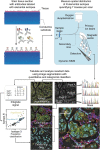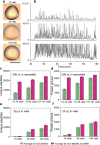Spatially Resolved Mass Spectrometry at the Single Cell: Recent Innovations in Proteomics and Metabolomics
- PMID: 33656885
- PMCID: PMC8033567
- DOI: 10.1021/jasms.0c00439
Spatially Resolved Mass Spectrometry at the Single Cell: Recent Innovations in Proteomics and Metabolomics
Abstract
Biological systems are composed of heterogeneous populations of cells that intercommunicate to form a functional living tissue. Biological function varies greatly across populations of cells, as each single cell has a unique transcriptome, proteome, and metabolome that translates to functional differences within single species and across kingdoms. Over the past decade, substantial advancements in our ability to characterize omic profiles on a single cell level have occurred, including in multiple spectroscopic and mass spectrometry (MS)-based techniques. Of these technologies, spatially resolved mass spectrometry approaches, including mass spectrometry imaging (MSI), have shown the most progress for single cell proteomics and metabolomics. For example, reporter-based methods using heavy metal tags have allowed for targeted MS investigation of the proteome at the subcellular level, and development of technologies such as laser ablation electrospray ionization mass spectrometry (LAESI-MS) now mean that dynamic metabolomics can be performed in situ. In this Perspective, we showcase advancements in single cell spatial metabolomics and proteomics over the past decade and highlight important aspects related to high-throughput screening, data analysis, and more which are vital to the success of achieving proteomic and metabolomic profiling at the single cell scale. Finally, using this broad literature summary, we provide a perspective on how the next decade may unfold in the area of single cell MS-based proteomics and metabolomics.
Keywords: DESI; LAESI; LDI; MALDI; NanoDESI; SIMS; high-throughput omics; mass spectrometry imaging.
Conflict of interest statement
The authors declare no competing financial interest.
Figures








Similar articles
-
Ambient Single-Cell Analysis and Native Tissue Imaging Using Laser-Ablation Electrospray Ionization Mass Spectrometry with Increased Spatial Resolution.J Am Soc Mass Spectrom. 2021 Sep 1;32(9):2490-2494. doi: 10.1021/jasms.1c00149. Epub 2021 Aug 10. J Am Soc Mass Spectrom. 2021. PMID: 34374553
-
Relative quantitation in single-cell metabolomics by laser ablation electrospray mass spectrometry.Methods Mol Biol. 2014;1083:31-9. doi: 10.1007/978-1-62703-661-0_3. Methods Mol Biol. 2014. PMID: 24218208
-
Towards high throughput and high information coverage: advanced single-cell mass spectrometric techniques.Anal Bioanal Chem. 2022 Jan;414(1):219-233. doi: 10.1007/s00216-021-03624-w. Epub 2021 Aug 26. Anal Bioanal Chem. 2022. PMID: 34435209 Review.
-
Recent Developments in Single-Cell Metabolomics by Mass Spectrometry─A Perspective.J Proteome Res. 2025 Apr 4;24(4):1493-1518. doi: 10.1021/acs.jproteome.4c00646. Epub 2024 Oct 22. J Proteome Res. 2025. PMID: 39437423 Free PMC article. Review.
-
Recent advances in single-cell analysis by mass spectrometry.Analyst. 2019 Jan 28;144(3):824-845. doi: 10.1039/c8an01190g. Analyst. 2019. PMID: 30334031 Review.
Cited by
-
Mapping the single cell spatial immune landscapes of the melanoma microenvironment.Clin Exp Metastasis. 2024 Aug;41(4):301-312. doi: 10.1007/s10585-023-10252-4. Epub 2024 Jan 13. Clin Exp Metastasis. 2024. PMID: 38217840 Free PMC article. Review.
-
Role of necroptosis in kidney health and disease.Nat Rev Nephrol. 2023 May;19(5):300-314. doi: 10.1038/s41581-022-00658-w. Epub 2023 Jan 3. Nat Rev Nephrol. 2023. PMID: 36596919 Review.
-
Mass Spectrometry Imaging Spatial Tissue Analysis toward Personalized Medicine.Life (Basel). 2022 Jul 12;12(7):1037. doi: 10.3390/life12071037. Life (Basel). 2022. PMID: 35888125 Free PMC article. Review.
-
Dissecting Host-Pathogen Interactions in TB Using Systems-Based Omic Approaches.Front Immunol. 2021 Nov 2;12:762315. doi: 10.3389/fimmu.2021.762315. eCollection 2021. Front Immunol. 2021. PMID: 34795672 Free PMC article. Review.
-
Exploring Single-Cell Exposomics by Mass Spectrometry.Environ Sci Technol. 2023 Aug 22;57(33):12201-12209. doi: 10.1021/acs.est.3c04524. Epub 2023 Aug 10. Environ Sci Technol. 2023. PMID: 37561608 Free PMC article. Review.
References
-
- Ankrah N. Y. D.; May A. L.; Middleton J. L.; Jones D. R.; Hadden M. K.; Gooding J. R.; LeCleir G. R.; Wilhelm S. W.; Campagna S. R.; Buchan A. Phage Infection of an Environmentally Relevant Marine Bacterium Alters Host Metabolism and Lysate Composition. ISME J. 2014, 8 (5), 1089–1100. 10.1038/ismej.2013.216. - DOI - PMC - PubMed
Publication types
MeSH terms
Grants and funding
LinkOut - more resources
Full Text Sources
Other Literature Sources
Miscellaneous

